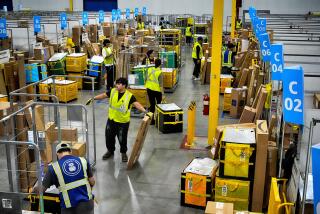U.S. Economy Shows More Signs of Slowing
- Share via
WASHINGTON — Evidence of a U.S. economic slowdown grew Wednesday with fresh signs the nation’s manufacturing sector is losing steam and a Federal Reserve survey showing reduced activity across much of the country.
A separate report showed that construction activity remained robust in the world’s top economy, however.
The National Assn. of Purchasing Management said its key index of manufacturing activity slipped to 48.3 in October from 49.9 in September, remaining below the crucial level of 50 and indicating that one-fifth of the economy is shrinking.
“Manufacturing is struggling much worse than the non-manufacturing sector of the economy,” said Norbert Ore, chairman of NAPM’s business survey committee. “Manufacturing is taking a hard lick from the economy’s downturn, but the overall economy is still in fairly good shape.”
Investors read the news as reinforcing market expectations that the inflation-wary Federal Reserve will hold key interest rates steady when it next meets to talk strategy Nov. 15.
The bellwether manufacturing activity number has been declining since peaking in September 1999, suggesting the Fed’s careful rate-rise campaign has begun to slow the economy.
In its latest regional survey, known as the “beige book,” the Fed said the U.S. economy grew moderately in September and early October but was starting to lose steam in parts of the country.
“Reports from Federal Reserve Banks generally described the regional economies as growing at a moderate pace . . . but with additional signs of slowing growth in some areas,” said the Fed’s summary, which will be used by policymakers at their meeting in two weeks’ time.
The report also cited a continuing slowdown in new-home sales and building as well as signs in some areas that commercial real estate markets might be starting to lose some strength.
However, the survey noted that U.S. labor markets remained tight and said some regions had experienced increasing wage pressures. Labor shortages, combined with higher fuel prices and competition from imports, were pressuring some manufacturers, it added.
A Commerce Department report that said spending on U.S. construction projects surged in September to the second-highest level on record as spending on nonresidential buildings such as offices and factories hit all-time highs may well keep the Fed on guard for renewed inflation signs. However, construction spending is perceived by economists as a secondary indicator.
Construction spending rose 2.4% to an annual rate of $819.3 billion after a 1.8% gain in August. September’s gains were much stronger than the 0.4% gain forecast by economists in a Reuters poll and was the largest percentage gain since a 2.6% rise in November 1999.
(BEGIN TEXT OF INFOBOX / INFOGRAPHIC)
Construction Spending
In billions of dollars, seasonally adjusted:
September: $819.3 billion
Source: Department of Commerce
(BEGIN TEXT OF INFOBOX / INFOGRAPHIC)
Purchasing Managers’ Index
Tracks overall business activity of more than 300 industrial companies.
October: 48.3%
Source: National Assn. of Purchasing Management
More to Read
Inside the business of entertainment
The Wide Shot brings you news, analysis and insights on everything from streaming wars to production — and what it all means for the future.
You may occasionally receive promotional content from the Los Angeles Times.










